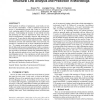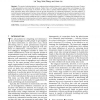405 search results - page 13 / 81 » A method to predict social annotations |
BMCBI
2010
13 years 10 months ago
2010
Background: The rapid development of structural genomics has resulted in many "unknown function" proteins being deposited in Protein Data Bank (PDB), thus, the functiona...
CIKM
2011
Springer
12 years 9 months ago
2011
Springer
With hundreds of millions of participants, social media services have become commonplace. Unlike a traditional social network service, a microblogging network like Twitter is a hy...
TKDE
2012
12 years 4 days ago
2012
—This study of collective behavior is to understand how individuals behave in a social networking environment. Oceans of data generated by social media like Facebook, Twitter, Fl...
ICPR
2008
IEEE
2008
IEEE
Gene function prediction using protein domain probability and hierarchical Gene Ontology information
14 years 4 months ago
The Gene Ontology (GO) is a controlled vocabulary of terms to describe protein functions. It also includes a hierarchical description of the relationships among the terms in the f...
WWW
2011
ACM
13 years 4 months ago
2011
ACM
Facial attributes such as gender, race, age, hair style, etc., carry rich information for locating designated persons and profiling the communities from image/video collections (...


